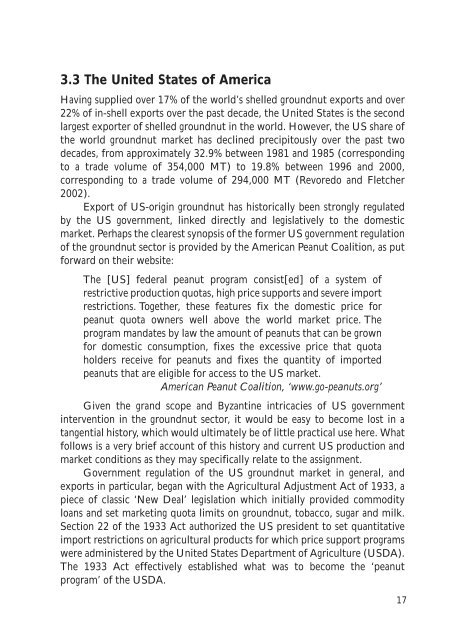Market Prospects for Groundnut in West Africa COMMON FUND ...
Market Prospects for Groundnut in West Africa COMMON FUND ...
Market Prospects for Groundnut in West Africa COMMON FUND ...
Create successful ePaper yourself
Turn your PDF publications into a flip-book with our unique Google optimized e-Paper software.
3.3 The United States of America<br />
Hav<strong>in</strong>g supplied over 17% of the world’s shelled groundnut exports and over<br />
22% of <strong>in</strong>-shell exports over the past decade, the United States is the second<br />
largest exporter of shelled groundnut <strong>in</strong> the world. However, the US share of<br />
the world groundnut market has decl<strong>in</strong>ed precipitously over the past two<br />
decades, from approximately 32.9% between 1981 and 1985 (correspond<strong>in</strong>g<br />
to a trade volume of 354,000 MT) to 19.8% between 1996 and 2000,<br />
correspond<strong>in</strong>g to a trade volume of 294,000 MT (Revoredo and Fletcher<br />
2002).<br />
Export of US-orig<strong>in</strong> groundnut has historically been strongly regulated<br />
by the US government, l<strong>in</strong>ked directly and legislatively to the domestic<br />
market. Perhaps the clearest synopsis of the <strong>for</strong>mer US government regulation<br />
of the groundnut sector is provided by the American Peanut Coalition, as put<br />
<strong>for</strong>ward on their website:<br />
The [US] federal peanut program consist[ed] of a system of<br />
restrictive production quotas, high price supports and severe import<br />
restrictions. Together, these features fix the domestic price <strong>for</strong><br />
peanut quota owners well above the world market price. The<br />
program mandates by law the amount of peanuts that can be grown<br />
<strong>for</strong> domestic consumption, fixes the excessive price that quota<br />
holders receive <strong>for</strong> peanuts and fixes the quantity of imported<br />
peanuts that are eligible <strong>for</strong> access to the US market.<br />
American Peanut Coalition, ‘www.go-peanuts.org’<br />
Given the grand scope and Byzant<strong>in</strong>e <strong>in</strong>tricacies of US government<br />
<strong>in</strong>tervention <strong>in</strong> the groundnut sector, it would be easy to become lost <strong>in</strong> a<br />
tangential history, which would ultimately be of little practical use here. What<br />
follows is a very brief account of this history and current US production and<br />
market conditions as they may specifically relate to the assignment.<br />
Government regulation of the US groundnut market <strong>in</strong> general, and<br />
exports <strong>in</strong> particular, began with the Agricultural Adjustment Act of 1933, a<br />
piece of classic ‘New Deal’ legislation which <strong>in</strong>itially provided commodity<br />
loans and set market<strong>in</strong>g quota limits on groundnut, tobacco, sugar and milk.<br />
Section 22 of the 1933 Act authorized the US president to set quantitative<br />
import restrictions on agricultural products <strong>for</strong> which price support programs<br />
were adm<strong>in</strong>istered by the United States Department of Agriculture (USDA).<br />
The 1933 Act effectively established what was to become the ‘peanut<br />
program’ of the USDA.<br />
17

















